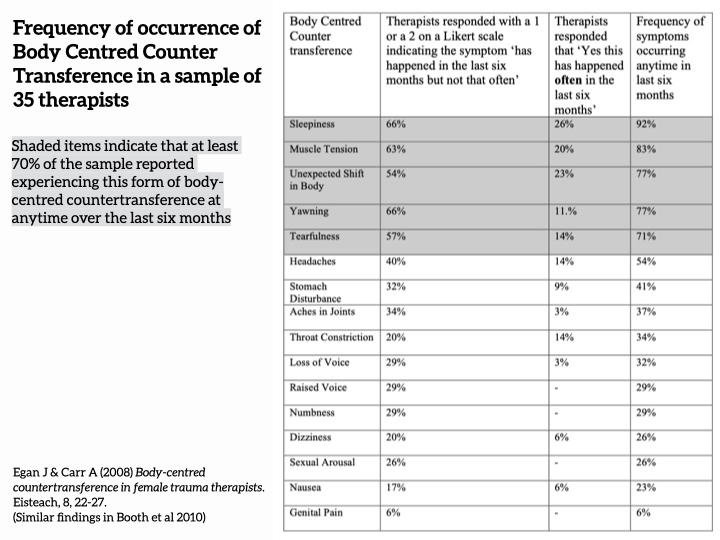
Overview
Connection to the body is the foundation of connection to self, connection to others, and connection to the natural world.
Transference is when feelings, attitudes, associations originally experienced with important people from the past are transferred onto to someone else. Connection to our lived body, our sense of self, sometimes becomes confused as we connect to others. When we occupy the role of a therapist it can be especially hard to be clear of the boundary of ‘this is me, this is them’.
You remind me of my dad, I didn’t like my dad. I don’t like you.
Typically the transference (sometimes called projection) model is used to help understand how clients interact with a talking treatment therapist. Here we want to explore transference/ countertransference for bodyworkers.
The unconscious process in transference maybe: ‘You remind me of my dad, I didn’t like my dad. I don’t like you.’ The current relationship is not experienced as it actually is, but as a mosaic of the past and present.
Countertransference are the thoughts, feelings and emotional responses that the therapist experiences in response to the clients transference. If the therapist is not careful, being treated like a parent may lead the therapist to unconsciously treat the client like a child.
It is important to note that the therapeutic space is not just a world of emotions and thoughts. Your responses will be embodied. You and your client will inevitably shape each other and mirror each other as the relationship deepens.
A common scenario is for the therapist to not realise they feel judged or attacked. The therapist then acts as if they need to defend and is knowingly or unknowingly managing defence cascades inside their body causing them to speed up or withdrawal.
Allow feelings that may be judged harshly or feel shameful in social situations to be acknowledged.
Being aware of these interactions can help the therapist to understand the meaning of the clients communication and respond from a less defended and more present awareness.
Try to be open and honest with yourself. Allow feelings that may be judged harshly or feel shameful in social situations to be acknowledged. It is common for stories of attraction, disgust, hate, fear, needing to be liked, wanting friendship, inadequacy to be themes in the therapeutic relationship.
Self care is important in the therapeutic process. Better to know that not know. This will support more acceptance and presence inside you. Better to name the undercurrents and hidden needs than let them hijack you. Supervision is always recommended to keep exploring your ability to relate from as clear, neutral and open presence as possible.
Felt Sense:
‘In focusing therapy, vague bodily feelings that are thought to correspond to unresolved emotional conflicts, which tend to resolve when one simply pays attention to them.’
Eugene Gendlin https://dictionary.apa.org/felt-sense Accessed 2021-02-24
You and your client will inevitably shape each other and mirror each other as the relationship deepens.
Self Awareness Exercise: Exploring body centred countertransference
1. What is your baseline felt sense?
- Feel your body. Try to find specific sensations and detailed areas of the body. Where do you feel warm or cold, tense or relaxed, big or small?
- Are there places in your body that seem to call to your attention or disappear?
- How is your breathing? Deep, shallow, chest, belly?
- Is there a word, image, phase or emotion that matches to what you feel as you start?
- Choose a client or colleague. Maybe someone where there is something sticky or unresolved or there is conflict in the relationship.
2. As you think of the other person, what do you sense in your body?
- Where do you tense, relax, become warm, cold, feel bigger, smaller?
- Does your breathing change?
- Does your body want to move? How would you move? What happens if you follow the movement?
- What fantasies or other pictures come to mind? What words, stories, books, or songs come to mind?
3. What are the needs in the relationship?
- Is there something you want them to do?
- Is there something they want you to do?
- What might they like or not like about you?
- How similar or different are they from you?
- Do they remind you of someone in your history?
- Can you find one thing you can like about this person?
- If this person was an animal, what animal would they be?
- What animal would you be interacting with this person’s animal?
4. What have you learned?
- What personal fears are involved in working with this client?
- What are the signs of activation inside you in response to this person? How does your felt sense shift?
- What might help you to slow down and be with your responses? Is there a phrase you can take away or develop that might help you stay clear in future interactions?
- What would help you to better care for yourself with this client?
Steve Haines Feb 2021 Adapted from Babette Rothschild 1993
Transference and countertransference in psychotherapy
Transference is a term that has come out of psychotherapy to define what takes place when the client responds to the therapist as a key figure in their history. Basically it is redirection of feelings and desires to another person. This typically happens as the therapeutic process deepens and early childhood experiences are emerging.
It can come out in many ways but in simple terms the client behaves like the therapist is a parent figure or someone they have an unresolved relationship with and the interaction becomes coloured by it until the client resolves it.
Most of this is unconscious material that the client is not fully in relationship with or even partially in relationship with. A psychotherapist notices the behaviour of the client towards them to determine if the client is in transference.
As touch therapists we can experience this dynamic very powerfully at a somatic level because of the highly empathetic contact we have with the client’s physiology. You can start to experience unusual felt sense patterns that don’t feel familiar to your system, or emotions and thoughts that are unusual. These are almost certainly induced by the client’s transference state.
As touch therapists we can experience this dynamic very powerfully at a somatic level because of the highly empathetic contact we have with the client’s physiology.
As the client starts to access held experiences the affects can be felt by the therapist. Sometimes this can become highly charged and difficult for the therapist as well as confusing.
Transference has generated a wealth of research that illuminates how people tend to repeat relationship patterns from the past in the present.
In therapy transference is often manifested as an erotic attraction towards a therapist, but can be seen in many other forms such as rage, hatred, mistrust, parentification, dependence, or even placing the therapist in a god-like or guru status.
People tend to repeat relationship patterns from the past in the present.
Clinical Highlight: Examples of transference
- You meet someone at a party who reminds you of a favourite aunt and you find yourself feeling warmly towards this new acquaintance.
- A client who has difficulty depending on others may find themselves feeling resentful, jealous, or angry towards their therapist without realizing there is a connection between these feelings and the therapist’s upcoming vacation.
- A client who fears disapproval and rejection notices that they suddenly find themselves worried about judgment or criticism from their therapist when they start to talk about a certain topic or feel a particular feeling.
- A perpetually single client prone to distrusting people may begin to view the therapist with suspicion as their relationship deepens.
- A client who struggles with anger and hostility may find themselves similarly struggling with anger and hostility toward the therapist.
Rhythm is deeply embedded in our bodies, in our hearts, our breathing, our brains, our actions…
Our rhythms organize and synchronize our bodies and come to organize and synchronize our bodies with the bodies of others.
Barbara Tversky 2019
As the client starts to access held experiences the affects can be felt by the therapist. Sometimes this can become highly charged and difficult for the therapist as well as confusing.
Body centred countertransference
Bodyworkers generate a powerful empathetic relational field that often involves the bodyworker experiencing the physical state of the client during the treatment.
Also known as somatic countertransference, it can incorporate the therapist’s gut feelings, as well as changes to breathing, heart rate and to muscle tension. Here’s a list of commonly reported symptoms (Egan J. and Carr A. 2008 and Booth et al 2010):
- Sleepiness
- Muscle Tension
- Yawning
- Unexpected shift in body
- Tearfulness
- Headache
- Stomach disturbance
- Throat constriction
- Dizziness
- Aches in joints
- Nausea
- Numbness
- Sexual arousal

Working with boundaries
Counter-transference is often most powerfully felt with clients who are holding early difficult unresolved experiences in their body. Here’s a list of responses to this:
- The most important thing is to recognise what is happening as it happens. With experience you start to notice these transference patterns taking place in your system and recognise them as coming from the client and not your own system.
- Bodywork works best when the provider/therapist is in relationship with the client’s system in a neutral way. This can really help with mitigating these affects. Being in a grounded state will allow you to not be over empathetic to the client’s system.
- It helps enormously for your client to become aware of these patterns in their own system. So helping guide them to into felt sense awareness and come into relationship with unresolved patterns and their experiences brings about an internal shift resulting in a more inclusive physiology, one that isn’t partitioned.
- Naming what you are experiencing to the client can be a powerful way of opening a dialogue around the transference. Saying it in a neutral, non judgemental way is the art of dialogue in all bodywork. Keeping verbal interchange oriented to felt sense can generate a powerful tool for accessing held trauma affects.
- Helping your client connect with feelings of health in their body can greatly reduce these resonances. Particularly useful is for the client to open up to feelings of fluidity in their body. The therapist can help this by staying in relationship to their health and by their ability to self regulate. The tendency in sessions is for the client to draw the therapist in to a tissue dynamic in their own system. The embodied non-judgmental presence of the therapist is one of the most powerful healing forces in the therapeutic process.
References
Booth A, Trimble T, and Egan J. (2010) Body-centred countertransference in a sample of Irish Clinical Psychologists. The Irish Psychologist, 36, 284-289.
Bray B (2018) Past trauma in counselors-in-training: Help or hindrance? Counseling Today, May 20, 2018 http://bit.ly/2sQ9qCL
Egan J and Carr A (2008) Body-centred countertransference in female trauma therapists. Eisteach, 8, 22-27.
Gendlin, E. (1981) Focusing, revised edn. London: Bantam New Age Books.
Rothschild B (2000) The Body Remembers – The Psychophysiology of Trauma and Trauma Treatment. London: W.W. Norton. I learnt a version of the exercise given above in a workshop and it was attributed to Babette Rothschild from 1993.
Tversky B. 2019 Mind in Motion. How Action Shapes Thought. New York: Basic Books
Thanks to Ged Sumner www.bodyintelligence.com and Geoff Johnson www.gjjohnson.co.uk


